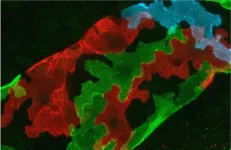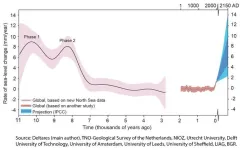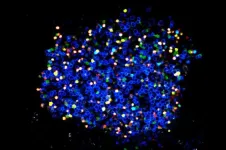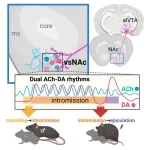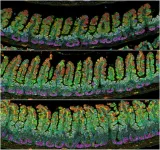(Press-News.org) For the first time, scientists have witnessed the very moment DNA begins to unravel, revealing a necessary molecular event for DNA to be the molecule that codes all life. A new study from King Abdullah University of Science and Technology (KAUST), published in Nature, captures the moment DNA begins to unwind, allowing for all the events that follow in DNA replication. This direct observation sheds light on the fundamental mechanisms that allow cells to faithfully duplicate their genetic material, a cornerstone for growth and reproduction.
Using cryo-electron microscopy and deep learning to observe the helicase Simian Virus 40 Large Tumor Antigen interacting with DNA, the laboratories of KAUST Assistant Professor Alfredo De Biasio and Professor Samir Hamdan provide the most detailed description yet of the very first steps of DNA replication: 15 atomic states that describe how the enzyme helicase forces the unwinding of DNA. The achievement is not only a milestone in helicase research, but also a milestone in observing the dynamics of any enzyme at atomic resolution.
While scientists have long known the importance of helicase in DNA replication, "they did not know how DNA, helicases and ATP work together in a coordinated cycle to drive DNA unwinding," De Biasio said.
When Watson and Crick reported the double helix in 1953, they gave the scientific community a breakthrough understanding of how genetic information is stored and copied. For DNA to replicate, the helix must first unwind and break the DNA from a double strand into two single strands.
Upon binding, helicases melt the DNA, breaking the chemicals bonds holding the double helix together. They then pull the two strands apart, allowing other enzymes to complete the replication. Without this first step, no DNA can be replicated. In this way, helicases are machines or, because of their size, nanomachines.
If helicases are nanomachines, then ‘ATP’, or adenosine trisphosphate, is the fuel. Much like how burning gas drives the pistons of a car engine, burning ATP, the same fuel used to flex your muscles, causes the six pistons of a helicase to unwind DNA. The study found that as ATP is consumed, it reduces physical constraints that allow the helicase to proceed along the DNA, unwinding more and more of the double strand. Thus, ATP consumption acts a switch that increases the amount of entropy – or disorder – in the system, freeing the helicase to move along the DNA.
"The helicase uses ATP not to pry DNA apart in one motion, but to cycle through conformational changes that progressively destabilize and separate the strands. ATP burning, or hydrolysis, functions like the spring in a mouse trap, snapping the helicase forward and pulling the DNA strands apart," said De Biasio.
Among the many discoveries made by the KAUST scientists was that two helicases melt the DNA at two sites at the same time to initiate the unwinding. The chemistry of DNA is such that nanomachines move along a single DNA strand in one direction only. By binding at two sites simultaneously, the helicases coordinate so that the winding can happen in both directions with an energy efficiency unique to natural nanomachines.
That efficiency, explains De Biasio, makes the study of DNA replication more than an attempt to answer the most fundamental scientific questions about life, it also makes helicases models for the design of new nanotechnology.
"From a design perspective, helicases exemplify energy-efficient mechanical systems. Engineered nanomachines using entropy switches could harness similar energy-efficient mechanisms to perform complex, force-driven tasks," he said.
END
Scientists see the first steps of DNA unwinding
Scientists report the most detailed account yet of the very first steps in DNA replication, an event that all life uses to grow and reproduce
2025-03-19
ELSE PRESS RELEASES FROM THIS DATE:
Earliest stages and possible new cause of stomach cancer revealed
2025-03-19
For the first time, scientists have systematically analysed somatic mutations in stomach lining tissue to unpick mutational processes, some of which can lead to cancer. The team also uncovered hints of a potential new cause of stomach cancer that needs further research.
Researchers at the Wellcome Sanger Institute, Broad Institute of MIT and Harvard, the University of Hong Kong, and their collaborators sequenced the whole genomes of normal stomach lining samples from people with and without gastric cancer.
The team ...
Unique cell shape keeps lymphatic vessels and plant leaves stable
2025-03-19
The cells that make up the walls of the finest of all lymphatic vessels have a lobate, oak leaf-like shape that makes them particularly resilient to changes in fluid volume. A similar cell shape also supports mechanical stability in plants. This has been shown by researchers from Uppsala University in a new article published in the journal Nature.
The lymphatic system consists of a network of lymph vessels that maintains the body’s fluid balance and supports the immune system. The finest of all these lymphatic vessels are called lymph capillaries. They have walls that are made up of just a single layer of lymphatic endothelial ...
New understanding of B cell mutation strategies could have implications for vaccines
2025-03-19
A vaccine's ability to generate long-lasting, high-affinity antibodies hinges on a delicate balance. Upon exposure to a vaccine or pathogen, B cells scramble to refine their defenses, rapidly mutating in hopes of generating the most effective antibodies. But each round of this process is a roll of the genetic dice—every mutation has the potential to improve affinity; far more often, however, it degrades or destroys a functional antibody. How do high-affinity B cells ever beat the odds?
New research now suggests that B cells avoid gambling away good mutations by strategically banking successful ones. As described in Nature, ...
Sea level rise after the last ice age: More knowledge
2025-03-19
New geological data has given more insight into the rate and magnitude of global sea level rise following the last ice age, about 11,700 years ago. This information is of great importance to understand the impact global warming has had on the ice caps and on sea level rise. The findings have been published in the scientific journal Nature by researchers from Deltares, Utrecht University, TNO Netherlands Geological Service, Delft University of Technology, the Netherlands Institute for Sea Research (NIOZ), University of Leeds, University of Sheffield, University of Amsterdam, LIAG and BGR.
Better ...
New mechanism behind adaptive immunity revealed. It could impact how we design vaccines.
2025-03-19
Germinal centers are high-speed evolution machines. Tiny clusters in the lymph nodes, germinal centers refine antibodies through mutation and expansion until they produce high-affinity B cells adapted to keep different pathogens in check. But rapid evolution should come at a cost. Most mutations are deleterious, so constant mutation during every cell division, coupled with unchecked proliferation, should be a recipe for disaster. How B cells somehow rapidly mutate and improve all at once was a long-standing mystery.
Now, advanced imaging techniques reveal the ...
Hyperuricemia: Current state and prospects
2025-03-19
Hyperuricemia (HU) is a metabolic disorder characterized by elevated uric acid (UA) levels in the bloodstream, commonly diagnosed when UA levels exceed 420 µmol/L (7 mg/dL) in men and 350 µmol/L (6 mg/dL) in women. Unlike other mammals, humans lack uricase, an enzyme that breaks down UA into a more soluble form, making them more susceptible to HU. The condition is influenced by genetic, dietary, and environmental factors, with contributors including purine-rich foods, metabolic dysfunctions, obesity, and ...
What happens in the male mouse brain during sex
2025-03-19
To uncover what drives sexual behavior in animals, researchers studied the brain activity of male mice throughout the series of actions involved in sex leading up to ejaculation. Their results, publishing in the Cell Press journal Neuron on March 19, show that the intricate dance in the brain area responsible for pleasure between two chemicals—dopamine and acetylcholine—controls the progression of sexual behavior. These findings could inspire treatments for disorders like premature ejaculation.
“Sexual behavior is a complex sequence of events,” says senior author Qinghua Liu of the National ...
Prescription stimulant use, misuse, and use disorder among US adults ages 18 to 64
2025-03-19
About The Study: Although access to prescription stimulants is essential to addressing important clinical needs of patients with attention-deficit/hyperactivity disorder (ADHD), this study found that among U.S. adults ages 18 to 64 using prescription stimulants, one-fourth reported misuse, and nearly one-tenth had prescription stimulant use disorder. The findings may suggest potential progress in addressing the mental health care gap for middle-aged women and the need for evidence-based clinical guidance and training on benefits ...
Suicide and self-harm events with GLP-1 receptor agonists in adults with diabetes or obesity
2025-03-19
About The Study: There is unlikely to be an increase in the very low incidence of suicide-related adverse events among individuals receiving glucagon-like peptide 1 receptor agonists (GLP-1 RAs) within the context of randomized clinical trials. While these findings may further ease concerns about these adverse effects, continued monitoring is warranted to identify particular patients who may be at risk as extended use of GLP-1 RAs expands.
Corresponding Author: To contact the corresponding author, Sean P. Heffron, MD, MS, MSc, email sean.heffron@nyulangone.org.
To access the embargoed study: ...
Pregnancy irreversibly remodels the mouse intestine
2025-03-19
Researchers at the Francis Crick Institute have found that the small intestine grows in response to pregnancy in mice. This partially irreversible change may help mice support a pregnancy and prepare for a second.
The organs of many female animals are remodelled by reproduction, but the underlying mechanisms behind the response of the gut to pregnancy have only recently begun to be investigated. For example, scientists previously identified that the fruit fly gut expands during reproduction.
In research published today in Cell, the same team found that pregnant mice had a longer small intestine from just seven days ...
LAST 30 PRESS RELEASES:
University of Oklahoma researcher awarded funding to pursue AI-powered material design
Exploring how the visual system recovers following injury
Support for parents with infants at pediatric check-ups leads to better reading and math skills in elementary school
Kids’ behavioral health is a growing share of family health costs
Day & night: Cancer disrupts the brain’s natural rhythm
COVID-19 vaccination significantly reduces risk to pregnant women and baby
The role of vaccination in maternal and perinatal outcomes associated with COVID-19 in pregnancy
Mayo Clinic smartwatch system helps parents shorten and defuse children's severe tantrums early
Behavioral health spending spikes to 40% of all children’s health expenditures, nearly doubling in a decade
Digital cognitive behavioral treatment for generalized anxiety disorder
Expenditures for pediatric behavioral health care over time and estimated family financial burden
Air conditioning in nursing homes and mortality during extreme heat
The Alps to lose a record number of glaciers in the next decade
What makes a good proton conductor?
New science reporting guide published for journalists in Bulgaria
New international study reveals major survival gaps among children with cancer
New science reporting guide published for journalists in Turkey
Scientists develop a smarter mRNA therapy that knows which cells to target
Neuroanatomy-informed brain–machine hybrid intelligence for robust acoustic target detection
Eight SwRI hydrogen projects funded by ENERGYWERX
The Lundquist Institute and its start-up company Vitalex Biosciences Announces Strategic Advancement of Second-Generation fungal Vaccine VXV-01 through Phase 1 Trials under $40 Million Competitive Con
Fine particles in pollution are associated with early signs of autoimmune disease
Review article | Towards a Global Ground-Based Earth Observatory (GGBEO): Leveraging existing systems and networks
Penn and UMich create world’s smallest programmable, autonomous robots
Cleveland researchers launch first major study to address ‘hidden performance killer’ in athletes
To connect across politics, try saying what you oppose
Modulating key interaction prevents virus from entering cells
Project explores barriers to NHS career progression facing international medical graduates
Jeonbuk National University researchers explore the impact of different seasonings on the flavor perception of Doenjang soup
Two Keck Medicine of USC Hospitals named Leapfrog Top Teaching Hospitals
[Press-News.org] Scientists see the first steps of DNA unwindingScientists report the most detailed account yet of the very first steps in DNA replication, an event that all life uses to grow and reproduce
